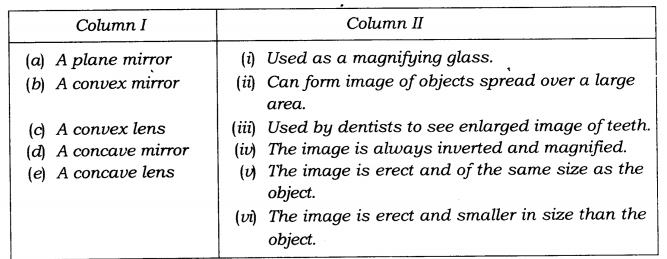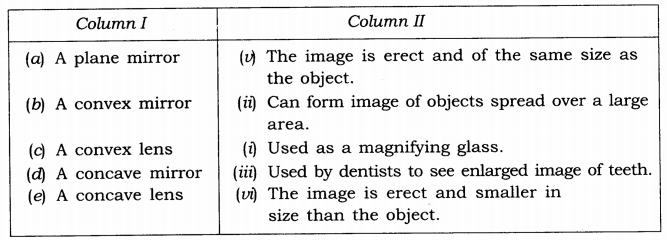Q.1.Fill in the blanks:
(a) An image that cannot be obtained on a screen is called ___________ .
(b) Image formed by a convex is __________ always virtual and smaller in size.
(c) An image formed by a __________ mirror is always of the same size as that of the object.
(d) An image which can be obtained on a screen is called a __________ image.
(e) An image formed by a concave __________ cannot be obtained on a screen.
Ans.(a) virtual image (b) mirror (c) plane (d) real (e) lens
Q.2.Mark ‘T’ if the statement is true and ‘F’ if it is false:
(a) We can obtain an enlarged and erect image by a convex mirror. (T/F)
(b) A concave lens always form a virtual image. (T/F)
(c) We can obtain a real, enlarged and inverted image by a concave mirror. (T/F)
(d) A real image cannot be obtained on a screen. (T/F)
(e) A concave mirror always form a real image. (T/F)
Ans. a) F (b) T (c) T (d) F (e) F
Q.3. Match the items given in Column I with one or more items of Column II

Ans.

Q.4.State the characteristics of the image formed by a plane mirror.
Ans.(i) Plane mirror forms an erect image.
(ii) It forms a virtual image.
(iii) Size of the image is same as that of the object.
(iv)Image is formed at the same distance behind the mirror as the object stands in front of it.
(v) Image formed is a laterally inverted image i.e., right hand side of the object seems to be the left hand side and vice-versa.
Q.5.Find out the letters of English alphabet or any other language known to you in which the image formed in a plane mirror appears exactly like the letter itself. Discuss your findings.
Ans.Letters like A, H, I, M, O, T, U ,V, W etc. appear same when seen through a plane mirror
Q.6.What is a virtual image? Give one situation where a virtual image is formed.
Ans.The image which cannot be taken on a screen is called virtual image. When some object is placed very close to the concave mirror we don’t get any image on the white screen placed behind the mirror. Such image is called virtual image.
Q.7. State two differences between a convex and a concave lens.

Q.8. Give one use each of a concave and a convex mirror.
Ans. Use of concave mirror:
Concave mirror is used by dentists to examine the teeth.
Use of convex mirror:
Convex mirror is used as side view mirror in vehicles
Q.9. Which type of mirror can form a real image?
Ans. Concave mirror can form a real image.
Q.10. Which type of lens forms always a virtual image?
Ans. Concave lens always forms a virtual image.
Choose the correct option in Questions 11-13:
Q.11. A virtual image larger than the object can be produced by a
(i) concave lens (ii) concave mirror (iii) convex mirror (iv) plane mirror
Ans. (ii) concave mirror
Q.12. David is observing his image in a plane mirror. Die distance between the mirror and his image is 4 m. If he moves 1 m towards the mirror, then the distance between David and his image will be
(i) 3 m (ii) 5 m (iii) 6 m (iv) 8 m
Ans. (iii) 6 m
Q.13. The rear view mirror of a car is a plane mirror. A driver is reversing his car at a speed of 2 m/s. The driver sees in his rear mew mirror the image of a truck parked behind his car. The speed at which the image of the truck appears to approach the driver will be
(i) 1 m/s (ii) 2 m/s (iii) 4 m/s {iv) 8 m/s
Ans. (ii) 4 m/s
1. What is the path of light?
Answer: Light travels along a straight line.
2. Why could Boojho not see the candle flame through a bent pipe?
Answer: Because light travels in a straight line, so it cannot bend around a pipe.
3. What happens when light falls on a polished surface?
Answer: The polished surface reflects the light, changing its direction.
4. What is the change in direction of light by a mirror called?
Answer: The change in direction of light by a mirror is called the reflection of light.
5. What do you observe when you look into a plane mirror?
Answer: You see an image of the same size as the object, erect and of the same distance behind the mirror.
6. What is the image formed by a plane mirror like?
Answer: The image formed is erect, of the same size, and at the same distance behind the mirror as the object is in front of it.
7. Can the image formed by a plane mirror be obtained on a screen?
Answer: No, the image formed by a plane mirror is a virtual image and cannot be obtained on a screen.
8. Why is the word “AMBULANCE” written in reverse on the front of the vehicle?
Answer: It is written in reverse so that drivers in front of the ambulance can read it correctly in their rearview mirror and give way.
9. What happens when you look at your image in a plane mirror and raise your left hand?
Answer: Your image raises its right hand, as mirrors reverse left and right sides.
10. What is the difference between the image formed by a plane mirror and the real image formed by a concave mirror?
Answer: A plane mirror forms a virtual image, while a concave mirror can form a real image that can be displayed on a screen.
11. How do concave mirrors change the size of the image?
Answer: A concave mirror can form either a larger or smaller image, depending on the distance of the object from the mirror.
12. What is a convex mirror used for?
Answer: A convex mirror is commonly used as a side-view mirror in vehicles, as it provides a wider field of view and forms smaller, erect images.
13. What happens when you look at your image in the convex side of a spoon?
Answer: The image will appear erect and smaller in size.
14. What happens when you look at your image in the concave side of a spoon?
Answer: The image will appear larger and inverted if the spoon is far away.
15. What is the function of a concave mirror in a torch?
Answer: Concave mirrors are used in torches to focus light into a beam.
16. What are spherical mirrors?
Answer: Spherical mirrors are mirrors that have a curved reflecting surface and can be concave or convex.
17. What is the shape of the reflecting surface in a concave mirror?
Answer: The reflecting surface of a concave mirror is curved inward, like the inside of a spoon.
18. What is the difference between a concave and convex mirror?
Answer: A concave mirror has an inward-curved reflecting surface, while a convex mirror has an outward-curved reflecting surface.
19. What happens when sunlight is focused by a concave mirror?
Answer: The sunlight gets focused to form a real image on a screen, and the light can even burn the paper if concentrated.
20. What happens when light falls on a concave mirror and the object is very close?
Answer: When the object is very close to a concave mirror, the image formed is virtual, erect, and larger.
21. What kind of image does a convex mirror form?
Answer: A convex mirror forms a virtual, erect, and smaller image of the object.
22. How can you prove that sunlight is made of multiple colors?
Answer: By passing sunlight through a glass prism, you can split it into seven colors (red, orange, yellow, green, blue, indigo, violet), showing that sunlight is a mixture of different colors.
23. What do you see when sunlight passes through a prism?
Answer: When sunlight passes through a prism, it splits into a spectrum of seven colors, resembling a rainbow.
24. What is a magnifying glass?
Answer: A magnifying glass is a convex lens used to magnify small objects.
25. What happens when you rotate a disc with seven rainbow colors on it quickly?
Answer: When you rotate the disc quickly, the colors mix together and appear white. This is called Newton’s disc.
26. What is a convex lens and what is its use?
Answer: A convex lens is a lens that is thicker in the middle and converges light. It is used in magnifying glasses, microscopes, and cameras.
27. What is the function of a concave lens?
Answer: A concave lens is thinner in the middle and diverges light. It is used in devices like spectacles to correct myopia (nearsightedness).
28. What happens when you use a concave lens with sunlight?
Answer: A concave lens does not focus sunlight into a bright spot, unlike a convex lens, because it diverges light.
29. Why is the word ‘AMBULANCE’ written in reverse on the vehicle?
Answer: It is written in reverse so that drivers can read it correctly in the rear-view mirrors of their vehicles and give way to the ambulance.
30. Why do the images in a convex mirror appear smaller than the objects?
Answer: Convex mirrors cause light rays to diverge, making the reflected image appear smaller and giving a wider field of view.
No Responses